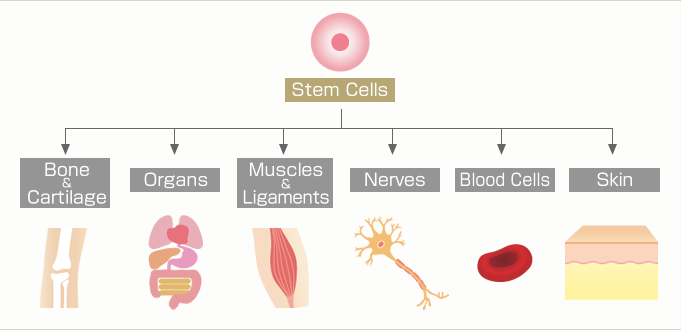
Have you heard of the "regenerative medicine using stem cells" that has been gaining attention in recent years? Treatments using human-derived stem cells are showing significant effects and generating new hope. There are several types of stem cells, including "adult stem cells," "ES cells," and "iPS cells," but the most advanced in clinical application are the "adult stem cells." These are stem cells found in various tissues throughout the body. Interestingly, the fat around our midsection, often considered a nuisance, actually contains a rich supply of stem cells. The treatment involves using "adipose-derived stem cells" extracted from the patient’s own subcutaneous fat.
What are Stem Cells?

The human body is made up of about 37 trillion cells, originating from a single fertilized egg and dividing into over 200 different types. Each cell has a specific role; for example, skin cells form skin, and blood cells form blood. However, there are cells without a fixed role that can become various types of cells and serve as the foundation for growing into different tissues and organs. These are called "stem cells."
Therapeutic Effects
The administration of "adipose-derived stem cells" into the body can move stem cells to organs causing illness or damaged areas, where they may reduce inflammation and promote repair and regeneration.
【Expected Benefits】
- ■Repair and regeneration of affected areas
- - Chronic pain
- Stroke
- Spinal cord injuries
- Liver cirrhosis
- Diabetes
- Rheumatoid arthritis
- Atopic dermatitis, etc.
- Treatment of ligaments and muscles damaged by sports, knees, and joints - ■Beauty Effects
- - Cellular-level anti-aging
Safety
This therapy:
1. Uses cells isolated and cultured from the patient's own cells, reducing the risk of rejection.
2. Allows relatively safe extraction with local anesthesia, as subcutaneous fat is close to the body surface.
3. Administers stem cells through intravenous infusion or directly to the affected area, adding convenience and reducing patient discomfort.
Side Effects
During fat extraction, there might be anesthesia allergies, subcutaneous bleeding, internal bleeding, muscle pain, and fever. Stem cell administration may cause allergies, fever, blood coagulation disorders, and pulmonary embolism.
Process from Fat Collection to Administration

-
- 1. Collect 5-10 grams of fat from the patient's abdomen.
- 2. Isolate mesenchymal stem cells.
- 3. Cultivate and produce the cell preparation (therapeutic drug).
- 4. Administer the cell preparation via intravenous drip or direct injection to the affected area.
| Menu | Price | |
|---|---|---|
| Human Stem Cell Exosome | First-time only | \165,000 |
| Regular price | \220,000 | |
| Autologous Adipose Stem Cells | Please inquire with our staff | |
(Prices include taxes)
Frequently Asked Questions

- Are there cases where cell culture is not possible?

- If infectious diseases are detected in the preoperative blood test or if there are abnormalities in blood coagulation (blood clotting), you cannot receive this treatment.

- Is there an age limit?

- Minors cannot receive this treatment.

- Is there a difference in effectiveness with age?

- Stem cells decrease with age. Although cells from younger individuals might be more robust, we cultivate and increase the number of stem cells and reintroduce them into the body, so older individuals might feel more significant effects.

- Are there risks associated with culturing and administering cells?

- Since we administer your own cells, there is no risk of rejection. However, some minor internal bleeding or inflammatory symptoms may occur. There is no significant risk associated with the administration.

- Will I truly experience effects from the cell insertion?

- You should feel the effects. However, there may be differences in the degree of effect. We recommend discussing the expected effects with your doctor before starting treatment.

- How long do the effects last?

- You should feel the effects after one treatment. However, it's not accurate to say that everything is resolved with one treatment. In reality, it's true that more treatments often lead to better results.













